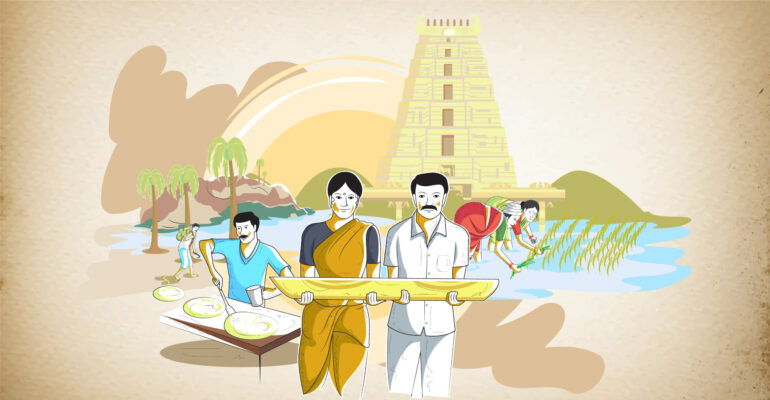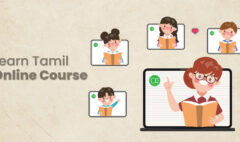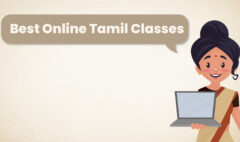Tamil People Facts For Kids
Tamil People Facts For Kids
Tamil is a principal language of the Dravidian family. It is one of the oldest in the world and is spoken by more than 80 million speakers across the world. The blog describes the richness of the literature, heritage, and the culture of Tamilians.
Tamilians are the ethnic and rich-cultured group of people from South Asia. Their language, literature and heritage is exceptionally rich and serves as their sole identity. If you have observed Tamils who have migrated or moved to other parts of the world for professional reasons, they are proud to identify themselves as Tamilians in spite of not speaking the language anymore. They always carry their love and respect for the language.
Read through the blog to find amazing facts about the tamil language that you must know and how old is Tamilian civilization along with details of its evolutionary phases.
Where do people speak Tamil?
Among 80 million Tamil speakers 63 million reside in India, 2.9 million live in Malaysia, 3.6 million in Sri Lanka and 4.3 lakh dwell in Singapore. Tamil is believed to be the ancestral language from many other languages like Malayalam, Telugu, and Kannada. If you are looking to learn Tamil through English or for fun learning for Tamil kids, it is important to understand Tamil culture facts, Tamil language history, and how old is Tamilian civilization.
Do you know that ‘Tamil’ is the only language personified as ‘God’? There is a temple for ‘Tamil Thai’ at Karaikudi in Tamil Nadu.
Tamil language history
The history of the Tamil language extends between five main periods. They are the pre-classical, classical, imperial, post-imperial, and modern periods.
The scripts found in the Indus Valley Civilization were inscribed in Tamil. Burial sites found of the megalithic era date the existence of the Tamil language to 10000 BC. Many excavations and researches prove this with precision. The origin of the Tamil people is connected with the Elamite people from Iran.
The classical period witnessed flourishing trade between Tamilians and people around the globe. Items that were traded include pearls, silk, ivory, black pepper, sapphires and diamonds. The three major royal dynasties also came into emergence during this period. A great number of coins belonging to Ancient Egypt and Rome were excavated in Karur. Pieces of pottery with Tamil writings on it were found in the Red Sea. Ambassadors were sent to Augustus who was the Roman Emperor and ports of Pandyas were called “The land of Punt”.
The imperial and post-imperial periods mark the time when Pallavas were defeated by the Cholas and Pandyas. Pallavas built enormous temples to worship Lord Shiva and Vishnu. The Cholas vastend their empire to a great extent that reached parts of Sri Lanka. Their navy reached countries such as Burma, Sumatra and Thailand. After a few years, the power of Cholas declined and Pandyas rose in authority. But, even their rule did not last for long.
The Pandyas and Cholas lost control over their reign. Different cultures and languages emerged following the emergence of local rules who garnered power and control. Different cultures and languages emerged in those places. Later local rulers emerged and took power. In due course foreigners from the United Kingdom, Denmark and France, started settling in Tamil lands along with taking control over it. After fighting numerous battles, the British took over the reign.
The Tamil lands were then integrated into a common territory by the British rulers. It was named the Madras Presidency. The Tamil speaking Ceylon colony in Srilanka was also a part of the British Empire. After India became independent in 1947, the presidency became Madras state which included parts from Karnataka, Kerala and Andhra Pradesh. Eventually when the partition of Indian states started on the basis of language, Tamil speakers were brought together under a common state which was later named Tamil Nadu. Considerable rights were given to people of Tamil nadu when they demanded for a separate country. Tamil is recognized as scheduled languages along with other 22 languages listed by the Indian Constitution. Tamil Nadu is a prosperous state in India in all walks of life.
Movements for Tamilian Upliftment
Tamil language houses rich heritage and culture. Tamil people all over the World came together to form the World Tamil Confederation. This association aimed to foster the Tamil language and promote it. It aims to instil a feeling of togetherness and brotherhood among Tamil people. It ensures a close tie and acts as a bridge between Tamil people living in different countries. They adopted a flag which unfurls to show up a quote, யாதும் ஊரே யாவரும் கேளிர் (Yadhum oorey yavarum kelir), which means “All lands are our home; all people are our kin.”
A very popular Tamil movement happened in Sri Lanka. A party called The Tamil Tigers emerged to fight for the basic rights of the Sri Lankan Tamils. They demanded a separate government in which Tamil people held a majority. This movement became tragic as the struggles and conflicts turned into a civil war and ended with a compromise. There were other notable, revolutionary movements that took place in Tamil’s own land, Tamil Nadu. This was led by the renowned social reformer, Periyar E. V. Ramasamy. He fought for alleviating casteism and to uplift the life of the underprivileged. He started the Self-respect Movement to empower people and protect them from being adversely impacted by social evils. Even today, there exists several political parties that have derived their ideologies from the principles of Periyar.
Tamil culture facts
The Tamil people excelled in various art forms. Majority of the Tamil speaking population, almost four-fifths of the them follow the religion, Hinduism and others follow Islam, Jainsim and Christianity. People follow sophisticated rituals and practices which include worshipping deities, animals and trees. Women usually wear a saree, which is a six yard long rectangular cloth draped in a particular way. Half-sarees and skirts and tops or pavadai sattai are worn by younger girls. Men wear a dhoti with a shirt and angavastram. South-indian food especially those from Tamil Nadu are said to get people drooling with its savouring taste and this is complemented by the traditional and healthy way of preparation.
A full meal feast on a banana leaf can rob one’s mind. It comprises of different dishes with the six tastes called the arusuvai unavu. Bharatanatyam is the traditional dance form of Tamil nadu. Karakattam, mayilattam, oyilattam, kuthu, parai are also other dance forms. Carnatic music is considered as a divine form of music which is intricate and elite. The iconic temples of kanchipuram, Tanjore and Madurai throws limelight to magnificent sculpture and art skills of ancient skills. The science and techniques behind the constructions are tremendous indeed.
Fun learning for Tamil kids?
Learn fun facts about Tamilians and amazing facts about the Tamil language that you must know by signing up to our online classes at Powerkid Tamil Academy. Learn Tamil online directly from the native Tamil speakers by being inside the comfort of your home.
Here, you get an opportunity to learn Tamil through English and as you learn Tamil online, you get an opportunity to interact and engage with qualified and experienced native Tamil speakers. Sign up at www.powerkidtamil.com or contact us at +1 (512) 575-3590 or +91 74033 33135. The right time to enrol in the online Tamil classes is now!








